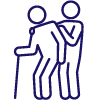- Yokohama-shi Top Page
- Nishi Ward Top Page
- Introduction of the ward
- Sightseeing
- Recommended course
- History walk
- Nishi Ward History Walk Michi Yokohama way
Here's the text.
Nishi Ward History Walk Michi Yokohama way
Last Updated January 17, 2019
In June 1858, the Shogunate decided to open Kanagawa (Yokohama) in June 1858, with the signing of the Japan-US Osamu Treaty of Commerce and Trade.
However, the city planning of Minato Yokohama was finally started in March, three months before the opening of the port. At that time, transportation from the Tokai route to Yokohama was very inconvenient, so the Shogunate opened a road called "Yokohama way" from Shibamura on the Tokai route (near the current Sengencho intersection) to Yokohama (Kannai). (At that time, the only way to contact the Tokaido was to pass from Hodogaya through Idogaya or Maita, or by boat from Kanagawa.)
This road builds a straight road from the lawn village through the wetlands of Okano and Hiranuma to Tobe Village, and also builds three bridges between Nitta, Hiranuma, and Ishizaki. The Otage Bridge (now Yoshidabashi Bridge) and Noge Bridge (Miyakobashi Bridge Bridge).
According to records, the width of the bridge at that time was three (less than 6m), and the road was probably equivalent to this. During the construction period of three months, the bridge was made of cedar for the balustrade and pine for the stake.
This path, which flourished as a major road to Shinkaichi Yokohama, has changed drastically with the passage of times, and now only slightly retains the impression of living.
Hiranuma Suitengu Shrine (Suitengu / Hiranuma Shrine)
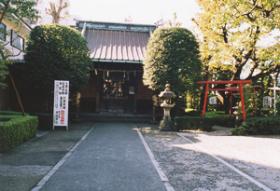
Hiranuma 2-8-10
In 1839 (1839), the fifth generation Kubei Hiranuma celebrated Suitengu as a guardian deity of Hiranuma Nitta. The precincts include Hiranuma Inari Shrine, Kamadomihashira Shrine, and Hiranuma Tenman-gu Shrine.
It is said that the Yudate Shinto ritual will be held every year at 10:00 am on January 5. It is said that drinking this hot water will not catch a cold.
Dengo Goromaru Tomb
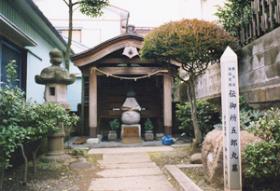
25, Goshoyamacho
There is an Olympic tower in Gosyoyama cho that is said to be the tomb of Goshogoromaru. Olympic towers are tombs and memorial towers of samurai and monks, which were made many from the Kamakura period to the Muromachi period.
Located in a place surrounded by a fence, the Dali stone slab on the right side of the gate is engraved with stories about Goromaru. The outline is, "On May 28, 1193 (1193), the night when Yoritomo Minamoto hunted Fuji, the Soga brothers defeated Suketsune Kudo, the enemy of his father. At that time, Goromaru led the Soga brothers to Yukei's House and made them achieve their full desire. "
A bronze statue of Kamon Ii
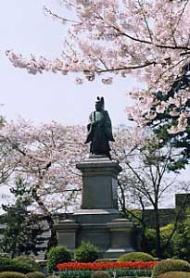
57, Momijigaoka
Naosuke Ii (1815-1860) is an elder at the end of the Tokugawa period. Hikone feudal lord. The head of Kamon. After taking office as an elder in 1858 (1858), he concluded the Japan-US Osamu Good Commerce Treaty without waiting for a royal royal court. He became the general manager of the opening of Yokohama Port. This led to an increase in opposition to the conclusion of the treaty, and later Ansei's prison was established. Based on that, he was assassinated outside Edo Castle Sakuradamon on March 3, 1860. He is familiar with Waka, Noh, and Iai, and in particular, in the tea ceremony, he has left famous books such as "Chayu Ichikaishu". The statue of Kamon Ii was erected in Kamonyama Park in 1909 to honor the opening of the port by the former Hikone feudal lord Naosuke Ii.
However, this statue was removed in 1943 for metal recovery during the war (1943), and the current statue was modeled on the statue of the elder Ii in Gotokuji, Setagaya-ku by Keiji Tancho (1954). It was cast in 1954. In addition, Yokohama Noh-theater was built in the park, and it was performed as "Kamonyama Firewood Noh" after Naosuke Ii loved.
Kanagawa magistrate's office
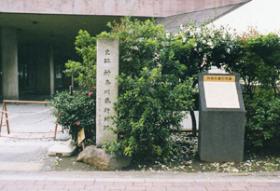
Next to Pref. Youth Center Main Building
The prefectural cultural center, which includes Pref.Library, Music Hall and Youth Center, is the site of a magistrate's office located in preparation for the opening of Yokohama Port. Opened on June 4, 1859 (1859), shortly after the opening of Yokohama Port, all five foreign magistrates, including Chikugo no Kami, who had been in charge of opening the port since July of the previous year, served as the original Kanagawa magistrate, and handled administrative affairs during the early days of Yokohama in rotation. The magistrate's offices were located here at the Tobe Office and Yokohama Unjosho (now Naka Ward), but the former was in charge of domestic affairs such as collecting tribute and prosecution trials, while the latter was in diplomatic affairs.
Iseyama Shrine
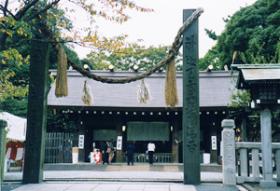
64, Miyazakicho
In 1870, Daijingu Shrine, which was originally located in Iseyama (currently near the northeastern end of Kamonyama Park), in the eastern part of Tobe Village, was moved to Mt. Noge in 1870 (1870) and named it Iseyama Shrine. As a result, the location was called Iseyama.
Naritasan Yokohama Besin Enmeiin
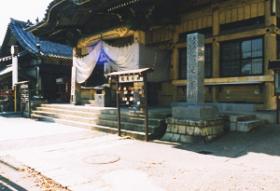
30, Miyazakicho
The main god is Fudo Myo. In 1870 (1870), Motoyama Naritasan Shinshoji recommended a spirit of spirit, and established a place of worship in the precincts of Fumonin in Otamura (now Nishinakacho, Minami-ku). . In 1999, the site was donated by Kaemon Takashima and moved to its current location, and changed it to Naritasan Church. Later, in 1893 (1893), the temple name was changed from Motoyama Toto (Tatsuchu) and called Enmeiin. It is commonly known as Noge Fudoson.
At the entrance of the stairs along the cliff, there is a pond of Fukumitsu Benzaiten with many turtles. If you go up a little, you will see three Inari, Fushimi, Toyokawa, and Shinei, as well as the statue of Ozunu Enno, Dainichi Nyorai, Fudoson, and 36 dojis. The water hall under the cliff is said to be a place for training in cold water.
Noge Yamairiguchi retaining wall (masonry retaining wall of former Senzo Hiranuma's residence)
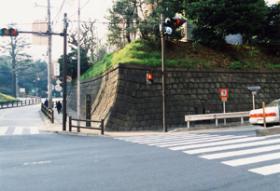
It's at the corner of the Nogezaka intersection. The masonry retaining wall of Senzo Hiranuma's residence, an Australian merchant living in Yokohama during the Meiji era. The enforcement accuracy of Kamekko masonry is the best in the city. It was built in the middle of the Meiji era.
Nogeyama Park
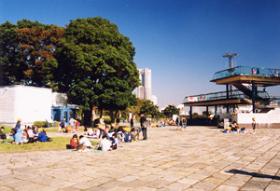
63-10, Oimatsucho
The park, including the zoo, is the site of the residence of the former Australian merchant Zenzaburo Hara, who once built a fortune in raw silk trade, and Sobee Mogi. There are about 380 cherry trees in Nogeyama Park, which are used by many cherry blossom visitors from late March to April during the flowering season.
Shozan Sakuma Honoring Monument
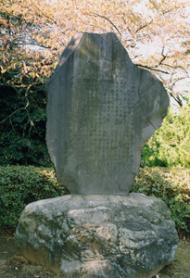
Military and Western scholars at the end of the Tokugawa period. Matsuyo feudal lord of Shinano (now Nagano Prefecture). He was an open scholar who had been calling for the opening of the country before the Kurofune incident, heard rumors about the opening of Shimoda in the Shogunate, criticized this, and rushed to the opening of Yokohama. He devoted himself to the construction of a new Japan, but died in Kyoto in 1864 without seeing the Meiji Restoration. In commemoration of the 100th anniversary of the opening of the country in 1954, a memorial monument was built in a corner of Nogeyama Park.
Inquiries to this page
Nishi Ward General Affairs Department Regional Promotion Division
Telephone: 045-320-8389
Telephone: 045-320-8389
Fax: 045-322-5063
Email address: ni-chiikishinko@city.yokohama.lg.jp
Page ID: 496-805-234








